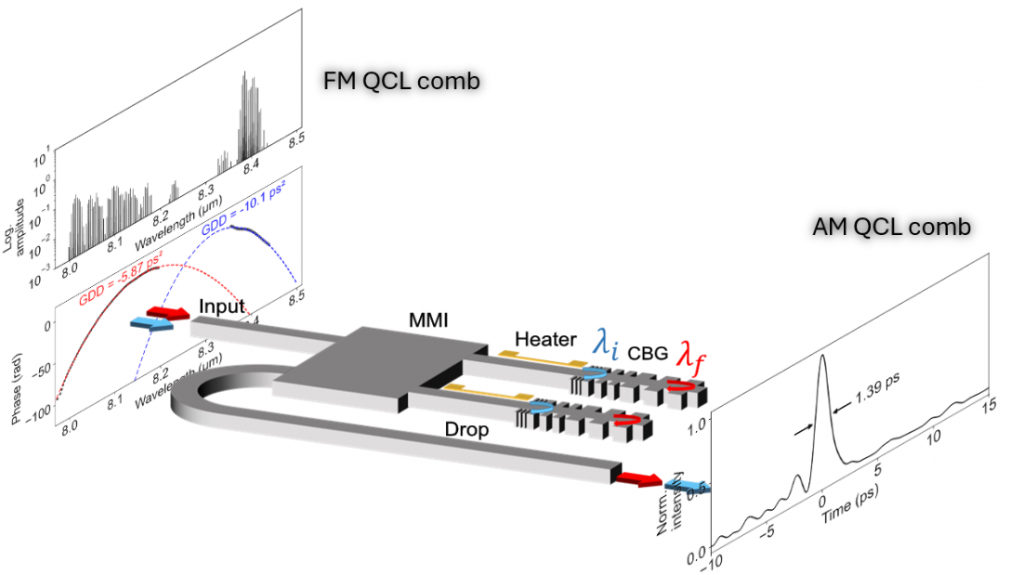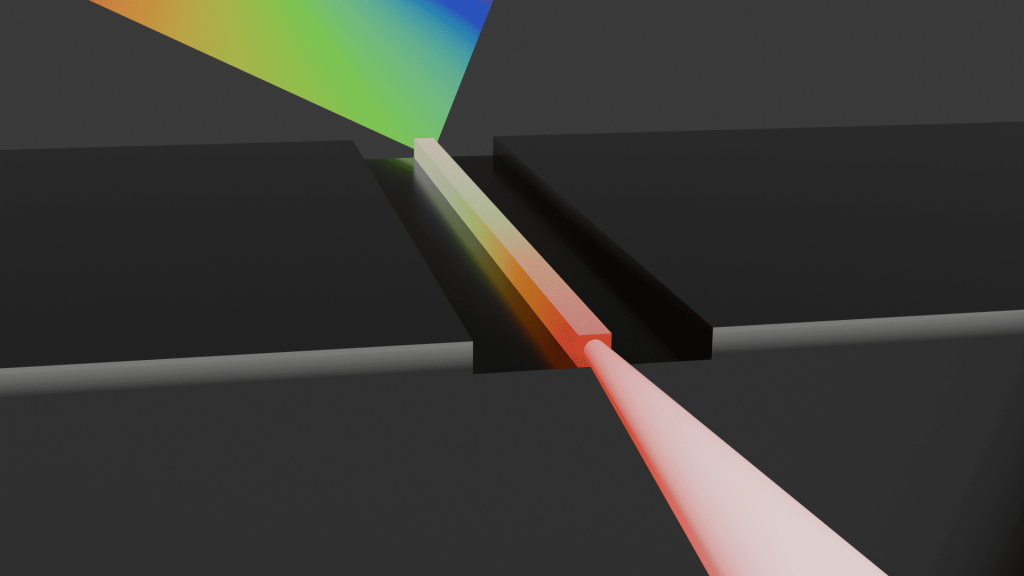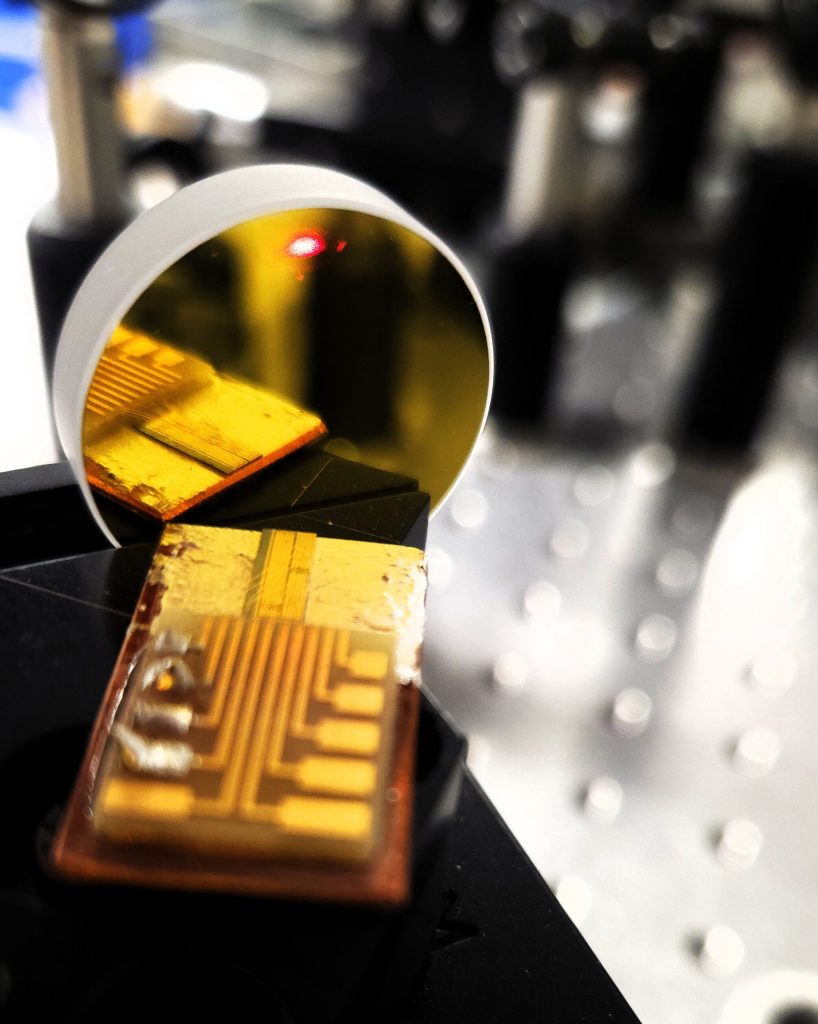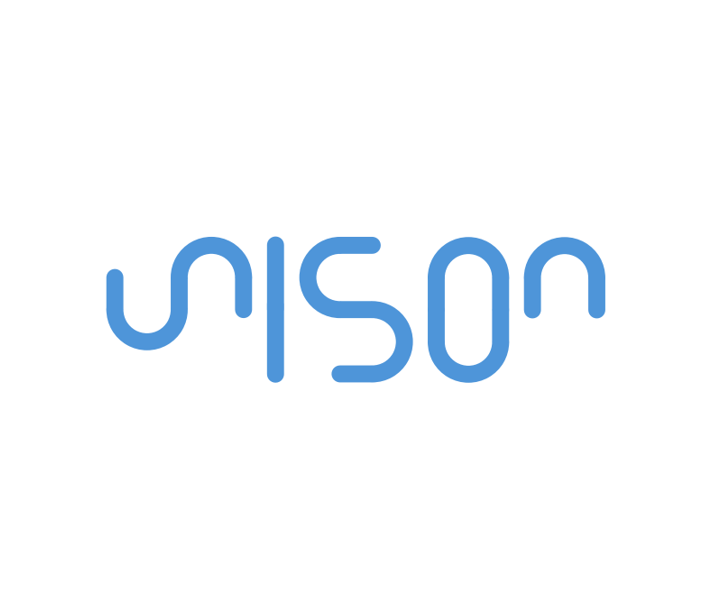Discover more of the technologies utilized in the UNISON project :
The mid-infrared wavelength range is widely used for spectroscopy and sensing. Ultrashort laser sources are very attractive for these applications, as they can enable ultrafast spectroscopy and multi-species chemical detection. However, until recently, the realization of ultrashort laser sources relied on bulky and expensive techniques, and significant efforts have been made to reduce their size and enable integration. In this work, we present an approach to generate pulses from a quantum cascade laser (QCL) frequency comb using integrated passive photonic circuits. QCLs are frequency-modulated combs, meaning that they exhibit a quasi-continuous temporal intensity profile and a quadratic spectral phase (chirp). Using silicon–germanium chirped Bragg gratings, we compensate for the quadratic phase of the QCL comb. This results in the generation of 1.39-ps-wide pulses, paving the way toward fully integrated ultrashort pulse generation.
By Annabelle BRICOUT
Read more on : “Pulse Generation by On-Chip Dispersion Compensation at 8µm Wavelength”


Mid-infrared spectroscopy presents one of the most widely used techniques to identify chemical substances. However, conventional commercially available spectroscopic systems are bulky and expensive, mainly due to light sources used. To circumvent this problem, mid-infrared integrated platforms providing broadband light sources represent a solution to both reduce the size, cost, and power consumption of spectroscopic systems, while improving their reliability. Quantum cascade lasers (QCLs) appear as natural light sources in the mid-infrared, but the emission spectrum of such sources remains limited. In this study, we show that it is possible to reduce the gap between the peak pulse power emitted by QCLs and the power required to trigger the generation of a type of broadband light spectrum through nonlinear effects, namely the supercontinuum. Peak powers of 311 W and above have been exploited to generate these peculiar light spectra in the Ge-rich graded SiGe platform, covering more than an octave in the 3.5 – 14 µm wavelength range. This represents a significant step towards the realization of compact and broadband mid-infrared light sources.
By Victor Turpaud
Read more on :“Low-power supercontinuum generation in Ge-rich SiGe waveguides from 4 to 13 μm wavelength” DOI: 10.1063/5.0270228
Miniature mid-infrared sensors based on Si(Ge) photonic integrated circuits (PICs) require the integration of III-V semiconductor lasers, as they are the only efficient compact laser sources. Of the various integration techniques, direct growth appears to be the most scalable and promising. However, the epitaxial growth of III-V semiconductors on group IV materials typically results in high defect densities. One particular defect, called an anti-phase boundary (APB), creates shortcuts in devices and must be avoided. Previously, we demonstrated that a rigorous growth strategy coupled with dedicated substrate preparation can bury APBs in a thin buffer layer when III-Vs are grown on Si substrates. In this article, we demonstrate that this approach can be extended to pure Ge substrates. Next, we investigate III-V growth on Ge layers grown on Si substrates or on SiGe-on-Si templates, the basis of UNISON’s platform. We demonstrate that, under certain conditions regarding the template morphology and growth approach, APBs can also be buried in the buffer layer. This paves the way for the epitaxial integration of lasers with SiGe-based PICs.
By Eric Tournié
Read more on :“MBE growth of GaSb on Ge-based templates grown on Si for mid-infrared photonics”


The development of efficient light sources and photonic devices operating in the mid-infrared has been one of the most exciting scientific challenges since the nineties. In fact, in this wavelength range situated between the visible light and microwave frequencies lie important features, like molecule fingerprints (e.g. CO2) as well as some atmospheric transparency windows. Mastering mid-infrared photonic systems would open new opportunities in various domains ranging from telecommunications to spectroscopy, as well as in astronomy where such signals have not been accessible yet. Among all light sources, broadband sources are particularly interesting as they enable powerful spectroscopic methods and other techniques such as data multiplexing. Previous work at different wavelengths has demonstrated that such sources can be obtained by combining a single-coloured laser with a resonator which traps light and leverages nonlinear effects to generate identical, regularly-spaced, ultra-short light pulses. However, the design of these resonators is challenging as usual platforms based on silicon absorb mid-infrared light. Introducing another mid-infrared transparent, silicon-compatible material, germanium, helps address this issue, but further improvements are required to enhance nonlinear effects.. Our publication presents a first step towards this goal, with compact ring-shaped silicon-germanium resonators designed to improve mid-infrared light confinement.
By Hamza Dely
Read more on :“Compact silicon-germanium microresonators for long-wave infrared frequencies” DOI: 10.1364/OE.570083
Infrared light, especially of wavelength between 3 and 12 µm, holds the key for the development of compact, battery-powered chemical sensors for a plethora of applications, including medical diagnostics, environmental monitoring and process control. However, it remains challenging to build adequate light sources for these sensors. There are mainly two technologies: quantum cascade lasers (QCL), which, over the last 3 decades, have matured into a commercially available platform, and interband cascade lasers (ICL), a much younger technology in that sense. When building sensors, having a light source that emits not one color, but a whole spectrum is key to detecting multiple species at once with a single device. One way to do that, is to drive the laser in a state, where it emits ultra-short pulses of light. This has been shown for visible light lasers. Since the ICL is a somewhat related technology, in contrast to QCLs, a lot of research went into getting it to emit pulses. Our current publication reveals why noone has succeeded in this endeavour so far: a design choice in their quantum heterostructure, which drastically boosts their performance, unfortunately also prevents this pulsed state. We suggest possible design changes to overcome this issue and set a new path for achieving this long-sought goal.
By Florian Pilat
Read more on :“Fast Gain Dynamics in Interband Cascade Lasers” DOI: 10.1002/lpor.202400867


